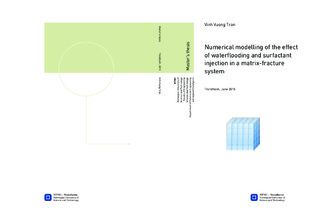| dc.description.abstract | Naturally fractured reservoirs in carbonate rocks usually contain more residual oil in the matrix than other reservoirs, due to the high permeability fracture zones that carries the flooded fluids, leaving parts of the reservoir untouched.
Studies on spontaneous imbibition with both water and surfactant has been conducted through simulations to exploit the fractures as a network to reach out to the matrices. Capillary pressure and interfacial tension modification on relative permeability curves has been done to represent the effect of surfactant injection
This study show that reducing the interfacial tension and capillary pressure by surfactant injection, will result in a slightly lower oil production initially, compared to regular waterflooding. However, the simulation study indicate that the oil production will eventually intersect the oil production curve for waterflooding and reach a higher final recovery.
The reservoir performance is improved through higher surfactant concentration as the CMC is being reached faster. In other words, the amount of surfactant in the system impact the reservoir performance significantly. | |

